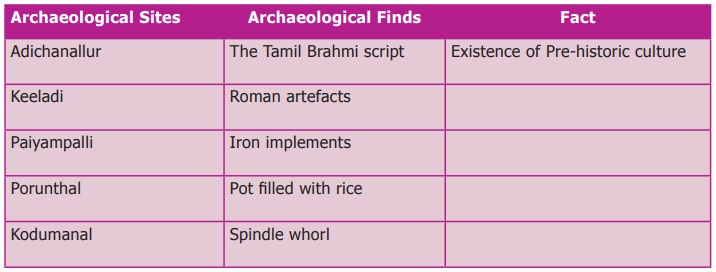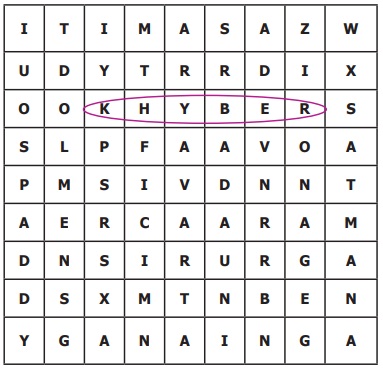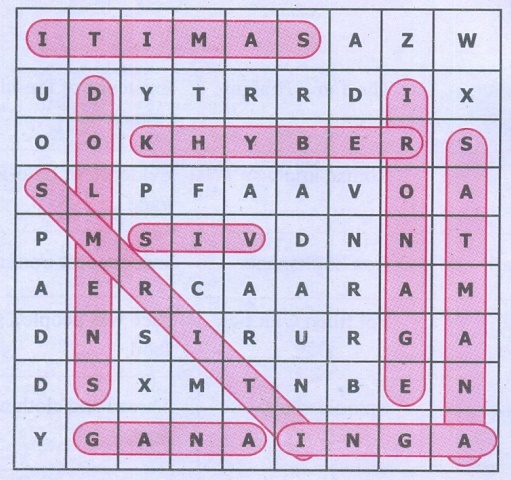Vedic Culture in North India and Megalithic Culture in South India | Term 2 Unit 1 | History | 6th Social Science - Exercises Questions with Answers | 6th Social Science : History : Term 2 Unit 1 : Vedic Culture in North India and Megalithic Culture in South India
Chapter: 6th Social Science : History : Term 2 Unit 1 : Vedic Culture in North India and Megalithic Culture in South India
Exercises Questions with Answers
EXERCISES
I. Choose the Correct answer
1. Aryans first settled in
________________ region.
a.
Punjab
b.
Middle Gangetic
c.
Kashmir
d.
North east
Answer: a) Punjab
2. Aryans came from____________.
a.
China
b.
North Asia
c.
Central Asia
d.
Europe
Answer: c) Central
Asia
3. Our National Motto “Sathyameva
Jayate” is taken from __________.
a)
Brahmana
b)
Veda
c)
Aranyaka
d)
Upanishad
Answer: d) Upanishad
4. What was the ratio of land
revenue collected during Vedic Age
a.
1/3
b.
1/6
c.
1/8
d.
1/9
Answer: b) 1/6
II. Match the
Statement with the Reason/Tick the appropriate answer:
1. Assertion : The vedic age is
evidenced by good number of texts and adequate amount of material evidences.
Reason: Shrutis
comprise the Vedas, the Brahmanas, the Aranyakas and the Upanishads.
a.
Both A and R are true and R is the correct explanation of A.
b.
Both A and R are true but R is not the correct explanation of A.
c.
A is true but R is false.
d.
A is false but R is true.
Answer:
2.
Statement I: Periplus mentions the
steel imported into Rome from peninsular India was subjected to duty in the
port of Alexandria.
Statement II:
Evidences for iron smelting has come to light at Paiyampalli.
a.
Statement I is wrong.
b.
Statement II is wrong.
c.
Both the statements are correct.
d.
Both the statements are wrong.
Answer: c) Both the statements are correct.
3. Which of the statement is not
correct in the Vedic society ?
a.
A widow could re-marry.
b.
Child marriage was in practice.
c.
Father’s property was inherited by his son.
d.
Sati was unknown.
Answer:
4. Which is the correct ascending
order of the Rig Vedic society?
a.
Grama ˂ Kula ˂ Vis ˂ Rashtra ˂ Jana
b.
Kula ˂ Grama ˂ Vis ˂ Jana ˂ Rashtra
c.
Rashtra ˂ Jana ˂ Grama ˂ Kula ˂ Vis
d.
Jana ˂ Grama ˂ Kula ˂ Vis ˂ Rashtra
Answer:
III. Fill in the
blanks
1.
Vedic culture was kinship-based in nature.
2. Bali was a tax collected from the people in Vedic period.
3. The Gurukula system is an ancient learning method.
4. Adhichanallur is in Thoothukudi district.
IV. True or False
1. The Roman
artefacts found at various sites provide the evidence of Indo – Roman trade
relations.
2.
A Hero Stone is a memorial stone raised in remembrance of the honourable death
of a hero.
3.
The army chief was called Gramani.
4.
The Black and Red ware pottery became the characteristic of the Megalithic
period.
5.
Evidence for iron smelting has come to light at paiyampalli.
V. Match the
following
Site / Finds
a)
Keezhadi 1) Ivory dice
b)
Porunthal 2) tip of ploughs
c)
Kodumanal 3) Spindles
d)
Adichanallur 4) gold ornaments
a.
4 3 2 1
b.
3 4 1 2
c.
1 3 4 2
d.
1 2 3 4
Answer: d) 1 2 3 4
VI Answer in one or
two sentence:
1. Name the four Vedas.
l. Rigveda, 2.Yajurveda, 3. Samaveda, 4. Atharvaveda
2. What were the animals
domesticated by Vedic people?
In the later Vedic period the Aryans tamed elephants,
apart from cow, goat, sheep and horse. Horses, cows, goats, sheep, oxen and
dogs were domesticated.
3. What do you know about
Megalith?
The term 'Megalith' is derived from Greek. 'Mega',
means great and 'lithos' means stone. Using big stone slabs on the places of
burial is known as Megalith.
4. What are Dolmens?
Dolmens are Megalithic tombs made of two or more
upright stones with a single stone lying across the burial site.
5. What are Urns?
Urns are large pottery jars used for burying the dead.
6. Name the coins used for
business transactions in Vedic period?
In Vedic period they used Nishka, Satmana (gold coins)
and Krishnala (silver coins) for business transactions.
7. Name some Megalithic monuments
found in Tamil Nadu.
Urns, Dolmens, Menhir and Hero stones are some of the
megalithic monuments found in Tamil Nadu.
VII Answer the
following
1. Write briefly about the
archaeological site at Kodumanal
Kodumanal is
identified with the Kodumanam of Pathitrupathu. More than 300 pottery
inscriptions in Tamil - Brahmi have been discovered there. Archaeologists have
also discovered spindles, whorls (used for making thread from cotton) and
pieces of cloth, along with tools, weapons, ornaments, beads, particularly carnelian.
A Menhir found at
burial site is assigned to the Megalithic period.
2. Write about the Vedic women in
a pragraph.
In Rig Vedic society,
women relatively enjoyed some freedom. The wife was respected as the mistress
of the household. She could perform rituals in her house. Child marriage and
sati were unknown. There was no bar on the remarriage of widows. Nevertheless,
the women were denied right to inherit property from their parents. They played
no role in public affairs.
In the later Vedic
period the role of women in society, as well as their status, even within the
family, declined. Women could no longer perform rituals in the family. The
rules of marriage became much more rigid. Polygamy became common. Widow
remarriage was not encouraged. Education was denied to women. Intercaste
marriages were spurned.
VIII HOTS
Difference
between Gurukula system of education and Modern system of education.
In the Gurukula system
of education, the sishyas stayed with the guru. They served the guru and learnt
their lessons. Rote learning and memorising lessons were insisted upon. In the
modem system of education, students come from homes or hostels. They need not
serve the teachers. Creative thinking is taught to students and they write
everything on paper.
IX Pride and Joy – Let us find out the fact

Archaeological Sites - Archaeological Finds - Fact
Adichanallur - The Tamil Brahmi script - Existence of Pre-historic culture
Keeladi - Roman artefacts - Evidence of Indo-Roman trade
Paiyampalli - Iron Implements - Evidence for iron smelting
Porunthal - pot filled with rice - Rice was people’s staple food.
Kodumanal - Spindle whorl - Thread and cloth were made
X.
Student Activity
1. Sentence making by using these new words.
Shruti, Gramani, Rashtras, Iron
Age, Semi nomadic, Barter
1.
The Shrutis
comprise the four Vedas, the Brahmanas, the Aranyakas and the Upanishads.
2.
Grama was headed by Gramani.
3.
The tribal kingdoms were called Rashtras.
4.
Iron axes and ploughs were widely used during Iron Age.
5.
Aryans of the Rig Vedic period were semi-nomadic.
6.
Exchange of goods is called barter system.
2. Word Search

1. A pass -
2. Text containing
teachings on religion -
3. A group of
villages -
4. A tribal assembly -
5. Assembly of
people -
6. Fire -
7. Gold coin -
8. Period of Vedic
Age -
9. Megalithic tomb -

XI Life
Skills
Collect information from
Newspapers about archaeological finds with the help of your teacher.
Site Visit
Visit to any one of the
archaeological sites near your locality.
XII Answer Grid:
Mention
two Ithikasas.
Ans: 1. Ramayana, 2. Mahabharatha
Vertical
monolithic pillar planted in memory of dead is called
Ans:
Menhir
Name
the ancient town in Sivagangai district dating to Sangam age.
Ans:
Keezhali
Name
any two Iron Age sites in Tamilnadu
Ans
: 1. Porunthal (Dindigul Dist.) 2. Paiyampalli (Vellore Dist.)
What
method of agriculture was practiced by early Aryans?
Ans
: Slash and burn agriculture
Name
two large cities that emerged during Vedic period.
Ans:
Ayodhya Indraprastha
Related Topics